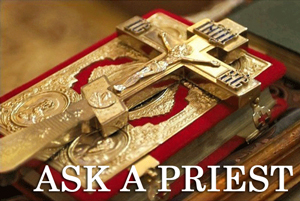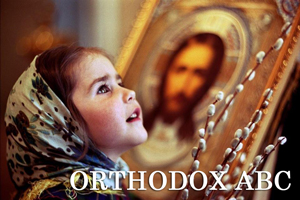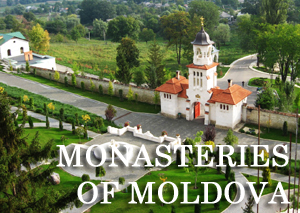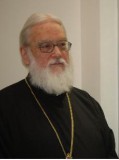
Heaven and earth are united today. — Hymn from the Vigil on Christmas Eve
O strange Orthodox Church! — Father Lev Gillet
An absence and a presence
I can remember exactly when my personal journey to Orthodoxy began. It happened quite unexpectedly one Saturday afternoon in the summer of 1952, when I was seventeen. I was walking along Buckingham Palace Road, close to Victoria Station in central London, when I passed a nineteenth-century Gothic church, large and somewhat dilapidated, that I had never noticed before. There was no proper notice-board outside it — public relations have never been the strong point of Orthodoxy in the Western world! — but I recall that there was a brass plate which simply said “Russian Church.”
As I entered St Philip’s — for that was the name of the church — at first I thought that it was entirely empty. Outside in the street there had been brilliant sunshine, but inside it was cool, cavernous and dark. As my eyes grew accustomed to the gloom, the first thing that caught my attention was an absence. There were no pews, no chairs in neat rows; in front of me stretched a wide and vacant expanse of polished floor.
Then I realized that the church was not altogether empty. Scattered in the nave and aisles there were a few worshipers, most of them elderly. Along the walls there were icons, with flickering lamps in front of them, and at the east end there were burning candles in front of the icon screen. Somewhere out of sight a choir was singing. After a while a deacon came out from the sanctuary and went round the church censing the icons and the people, and I noticed that his brocade vestment was old and slightly torn.
My initial impression of an absence was now replaced, with a sudden rush, by an overwhelming sense of presence. I felt that the church, so far from being empty, was full — full of countless unseen worshipers, surrounding me on every side. Intuitively I realized that we, the visible congregation, were part of a much larger whole, and that as we prayed we were being taken up into an action far greater than ourselves, into an undivided, all-embracing celebration that united time and eternity, things below with things above.
Years later, with a strange shock of recognition, I came across the story of St Vladimir’s conversion, recorded in the Russian Primary Chronicle. Returning to Kiev, the Russian envoys told the Prince about the Divine Liturgy which they had attended in Constantinople. “We knew not whether we were in heaven or on earth,” they said. “For on earth there is no such splendor or such beauty, and we are at a loss how to describe it. We only know that God dwells there among men… For we cannot forget that beauty.” The Russian Primary Chronicle, tr. S. H. Cross and 0. P. Sherbowitz-Wetzor (Cambridge, MA: The Mediaeval Academy of America, 1953), III. I started with amazement as I read those words, for such exactly had been my own experience at the Russian Vigil Service in St Philip’s, Buckingham Palace Road. The outward setting lacked the splendor of tenth-century Byzantium, but like St Vladimir’s emissaries I too had encountered “heaven on earth.” I too had felt the immediacy of the celestial Liturgy, the closeness of the angels and the saints, the uncreated beauty of God’s Kingdom. “Now the powers of heaven worship with us invisibly” (The Liturgy of the Presanctified Gifts).
Before the service had ended, I left the church; and as I emerged I was struck by two things. First, I found that I had no idea how long I had been inside. It might have been only twenty minutes, it might have been two hours; I could not say. I had been existing on a level at which clock-time was unimportant. Secondly, as I stepped out on the pavement the roar of the London traffic engulfed me all at once like a huge wave. The sound must have been audible within the church, but I had not noticed it. I had been in another world where time and traffic had no meaning; a world that was more real — I would almost say more solid — than that of twentieth-century London to which I now abruptly returned.
Everything at the Vigil Service was in Slavonic, and so with my conscious brain I could understand not a single word. Yet, as I left the church, I said to myself with a clear sense of conviction: This is where I belong; I have come home. Sometimes it happens — is it not curious? — that, before we have learnt anything in detail about a person, place or subject, we know with certainty: This is the person that I shall love, this is the place where I need to go, this is the subject that, above all others, I must spend my life exploring. From the moment of attending that service at St Philip’s, Buckingham Palace Road, I felt deep in my heart that I was marked out for the Orthodox Church. (The church, incidentally, has long since disappeared; it was demolished about four years after my visit.)
I am grateful that my initial contact with Orthodoxy was not through reading books, nor yet through meeting members of the Orthodox Church in a social context, but through attending an act of worship. The Church, according to the Orthodox understanding, is primarily a liturgical community, which expresses its true self through invocation and doxology. Worship comes first, doctrine and discipline second. I was fortunate, then, to discover Orthodoxy first of all by participating in an act of corporate prayer. I encountered the Orthodox Church not as a theory or an ideology, but as a concrete and specific fact, as a worshiping presence.
“This is what I have always believed…”
In retrospect it is clear to me that my mind was already made up on that summer afternoon in 1952. Before being actually received, however, I waited for nearly six years. In Britain in the 1950s it was a highly unusual step for a Western person to seek entry into the Orthodox Church, and most of my English friends did their best to dissuade me. “You will be a lifelong eccentric,” they objected. “God has set you culturally in the West; do not run away from the quandaries and the challenge of your historical inheritance.” However beautiful Orthodox worship might be, was there not (they asked) a tragic gap between Orthodox principles and Orthodox practice? Was not my approach to Orthodoxy too idealized, too sentimental? Was I perhaps looking for a security and protection that we can never enjoy here on earth, and should not seek?
Less predictably, most of the Orthodox whose counsel I sought likewise offered me little encouragement. They were honest and realistic — and for this I remain grateful — in directing my attention to the historical shortcomings of the Orthodox Church, as well as to the particular difficulties it confronts in the Western world. There was much in Orthodoxy, so they warned me, that was very far from “heaven on earth”! When I approached the assistant bishop at the Greek Cathedral in London, Bishop James (Virvos) of Apamaea, he spoke to me kindly and at length, but urged me to remain a member of the Anglican Church in which I had been brought up. A Russian priest to whom I spoke in Paris gave me exactly the same advice.
At the time this puzzled me. In my reading about Orthodoxy I had quickly discovered that it claims to be, not just one among many alternative “denominations,” but the true Church of Christ on earth. Yet it seemed as if the Orthodox themselves were telling me, “Yes, Orthodoxy is indeed the one true Church, but you should on no account join it. It is only for us Easterners, Greeks, Russians and the rest.” Adherence to the saving truth appeared to depend on the accidents of birth and geography.
With hindsight I can appreciate better why Bishop James spoke as he did. Forty or fifty years ago there were many Orthodox, and also many Anglicans, who sincerely hoped that the Anglican communion would be reconciled to Orthodoxy in a corporate way. Individual conversions from Anglicanism to the Orthodox Church were therefore discouraged; Anglicans, it was felt, would do better to remain where they were, and to work for unity from within their present Church, acting as an “Anglo-Orthodox” leaven.
I fear that these hopes for corporate reunion were always unrealistic. But it has to be remembered that, during the first half of the twentieth century, the moderate “High Church” party within Anglicanism — which bases itself upon an appeal to the Ecumenical Councils and the Fathers — was far stronger than it is today, whereas the extreme “liberal” tendency, with its doctrinal and moral relativism, was much less pronounced, although already plainly in evidence. At any rate Bishop James was by no means alone in his dream that High Anglicanism might eventually develop into the nucleus of a native-grown Western Orthodoxy.
Bishop James also had pastoral reasons. None of his parishes at that time used any English in their Sunday worship, and only a few of his clergy spoke anything but Greek. He was unwilling to accept British people into his care, lacking as he did the resources to look after them. In this he was surely in large measure justified; it is grossly irresponsible for Orthodox clergy to receive converts, and after that to do nothing further about them. (I can think of many cases where this has in fact happened.) Converts need to be integrated into a living community; they should not just be thrown in at the deep end of the Orthodox swimming-pool, and then left to their own devices to sink or swim.
Besides this, as I now realize, Bishop James wished to test me. Seeing my eagerness to become Orthodox, he wanted me to look carefully at the arguments on the other side. He knew that, if I was serious, I would come back to him again. And so indeed it turned out.
Meanwhile, some time before I had gone to see Bishop James, I began to develop a variety of Orthodox contacts. Shortly after my first experience of Orthodox worship at the Russian church in London, I started my university course at Oxford. For four years I studied Classics-ancient Greek and Latin, with some modern philosophy-and then I stayed on at the university for two further years of theology. (Incidentally, I never went to an Anglican theological college, nor was I ordained in the Church of England.) At Oxford I had the chance to meet Orthodox Christians at first hand. In particular I came to know Nicolas Zernov, the University Lecturer in Eastern Orthodox Culture, and I still recall with pleasure the generous hospitality dispensed by him and his wife Militza, and the exhilarating and unpredictable conversations that they used to initiate with their many guests. I also met Father (later Archbishop) Basil Krivocheine, who officiated at the small Russian chapel in Oxford, and who was preparing his classic edition of the Catecheses of St Symeon the New Theologian. A new world opened up before me as I heard him read St Symeon’s description of his visions of the divine and uncreated Light, and I began to appreciate the central place assigned in Orthodoxy to the mystery of Christ’s Transfiguration.
While at Oxford, under the influence of my close friend from school days, Donald (A. M.) Allchin, I became an active member of the Fellowship of St Alban and St Sergius, whose aim is to promote rapprochement between Orthodoxy and Anglicanism. The summer conferences of the Fellowship had a decisive effect on me. Here I listened to such Anglicans as Archbishop Michael Ramsey, Father Derwas Chitty, and Professor H. A. Hodges, all of whom regarded Orthodoxy as the integral fullness of the Christian tradition, to which Anglicanism needed to return. As they saw it, Anglicans could hold the full Orthodox faith while still remaining in the Church of England, and in this manner we could help to bring our fellow-Anglicans nearer to Orthodoxy.
Their enthusiasm fired my imagination, but a part of me remained unsatisfied. I longed to be Orthodox in a total and visible way. The more I learnt about Orthodoxy, the more I realized: this is what I have always believed in my inmost self, but never before did I hear it so well expressed. I did not find Orthodoxy archaic, foreign or exotic. To me it was nothing other than simple Christianity.
The Church is One
My early contacts with the Orthodox world were for the most part Russian. I devoured such books as A Treasury of Russian Spirituality by G. P. Fedotov, and With the Russian Pilgrims to Jerusalem by Stephen Graham. I was immediately attracted to St Seraphim of Sarov, about whom I learnt from Iulia de Beausobre’s slightly fictionalized but deeply moving account Flame in the Snow. On the more theological level a crucial landmark in my journey was Alexis Khomiakov’s short essay “The Church is One.” Here I found, verbally expressed, that vision of the communion of saints which I had first experienced as a living reality at the Russian church in London:
The Church is one, notwithstanding her division, as it appears to a man who is still alive on earth… Those who are alive on earth, those who have finished their earthly course, those who, like the angels, were not created for a life on earth, those in future generations who have not yet begun their earthly course, are all united together in one Church, in one and the same grace of God…The Church visible, or upon earth, lives in complete communion and unity with the whole body of the Church, of which Christ is the head… The Church, even upon earth, lives not an earthly life, but a life which is divine, and of grace… There is one God, and one Church. Alexis Khomiakov, “The Church is One,” in W. J. Birkbeck (ed.), Russia and the English Church during the Last Fifty Years (London: Eastern Church Association, 1895), 193-94, 211, 222.
In later years, as I read more widely in Orthodox theology, I came to recognize the limitations of Khomiakov’s Slavophil ecclesiology, but at the time he provided me with exactly what I needed. I was also greatly helped by Father Georges Florovsky’s article, “Sobornost: the Catholicity of the Church,” in which he emphasizes the essential nature of the Church as a unity-in-diversity after the image and likeness of God the Holy Trinity:
The realm of the Church is unity. And of course this unity is no outward one, but is inner, intimate, organic. It is the unity of the living body, the unity of the organism. The Church is a unity not only in the sense that it is one and unique; it is a unity, first of all, because its very being consists in reuniting separated and divided mankind. It is this unity which is the “sbornost”or catholicity of the Church. In the Church humanity passes over into another plane, begins a new manner of existence. A new life becomes possible, a true, whole and complete life, a catholic life, “in the unity of the Spirit, in the bond of peace” (Eph 4:3). A new existence begins, a new principle of life, “even as Thou, Father, art in Me, and I in Thee, that they also may be in Us… that they may be one even as We are one” Jn 17:21-23). This is the mystery of the final reunion in the image of the Unity of the Holy Trinity. Georges Florovsky, “Sobornost the Catholicity of the Church,” in E. L. Mascall (ed.), The Church of God. An Anglo-Russian Symposium by Members of the Fellowship of St Alban and St Sergius (London: SPCK, 1934) 55 (italics in the original). This article is reprinted in Vol. 1 of Florovsky’s Collected Works (Belmont, MA: Nordland, 1972).
Catholicity, Father Georges adds, “means seeing our own self in another, in the beloved one;” “Sobornost,” 59. and it is in the catholicity of the Church, and there alone, that “the painful duality and tension between freedom and authority is solved.” “Sobornost,” 73. Throughout my later life I have constantly returned to this article, which says far more in twenty-one pages than most authors manage to say in whole volumes.
While it was chiefly from the Russians that I received my initial insight into Orthodoxy, during my first visit to Greece in 1954 the spiritual world of Byzantium also won my allegiance. As a Classicist my main purpose had been to look at the Acropolis, Olympia, Delphi and Knossos. So, when my traveling companions included Sparta in our itinerary, I protested. Were not the Spartans mere gymnasts and militarists, who had left behind them no monument worthy of a detour? In fact what my friends were taking me to visit was not Sparta itself but the Byzantine town of Mistra three miles beyond. Here I was delighted to see before me not just a few scattered ruins but an entire city rising up the hillside — streets, palaces, monasteries, many-domed churches — all set against the spectacular back-drop of the snow-covered Taygetus range. Looking at the frescoed saints alive on the church walls, like W B. Yeats I found in them “the singing-masters of my soul.”
Tradition, martyrdom, stillness
As I deepened my knowledge of Orthodoxy, three things in particular attracted me and held me fast. First, I perceived in the contemporary Orthodox Church — despite its internal tensions and its human failings — a living and unbroken continuity with the Church of the Apostles and Martyrs, of the Fathers and the Ecumenical Councils. This living continuity was summed up for me in the words fullness and wholeness, but most of all it was expressed by the term Tradition. Orthodoxy possesses, not through human merit but by God’s grace, a fullness of faith and spiritual life, a fullness within which the elements of dogma and prayer, of theology and spirituality, constitute an integral and organic whole. It is in this sense the Church of Holy Tradition.
In this context I would like to put especial emphasis on the word “fullness.” Orthodoxy has the plenitude of life in Christ, but it does not have an exclusive monopoly of the truth. I did not believe then, nor do I believe now, that there is a stark and unmitigated contrast between Orthodox “light” and non-Orthodox “darkness.” We are not to imagine that, because Orthodoxy possesses the fullness of Holy Tradition, the other Christian bodies possess nothing at all. Far from it; I have never been convinced by the rigorist claim that sacramental life and the grace of the Holy Spirit can exist only within the visible limits of the Orthodox Church. Vladimir Lossky is surely right to maintain that, despite an outward separation, non-Orthodox communities still retain invisible links with the Orthodox Church:
Faithful to its vocation to assist the salvation of all, the Church of Christ values every “spark of life,” however small, in the dissident communities. In this way it bears witness to the fact that, despite the separation, they still retain a certain link with the unique and life-giving center, a link that is — so far as we are concerned — “invisible and beyond our understanding.” There is only one true Church, the sole bestower of sacramental grace; but there are several ways of being separated from that one true Church, and varying degrees of diminishing ecclesial reality outside its visible limits. Vladimir Lossky, introductory note to the article of Patriarch Sergius of Moscow, “L’Église du Christ et les communautés dissidentes,” Messager de I’Exarchat du Patriarche Russe en Europe Occidentale 21 (Paris, 1955), 9-10.
Thus on Lossky’s view, which I willingly made my own, non-Orthodox communities continue in varying degrees to participate in the Church’s life of grace. Yet it still remains true that, while these non-Orthodox communities possess part of the saving and life-giving truth, in Orthodoxy alone is the fullness of that truth to be found.
I was particularly impressed by the manner in which Orthodox thinkers, when speaking of their Church as the Church of Holy Tradition, insist at the same time that Tradition is not static but dynamic, not defensive but exploratory, not closed and backward-facing but open to the future. Tradition, I learnt from the authors whom I studied, is not merely a formal repetition of what was stated in the past, but it is an active reexperiencing of the Christian message in the present. The only true Tradition is living and creative, formed from the union of human freedom with the grace of the Spirit. This vital dynamism was summed up for me in Vladimir Lossky’s lapidary phrase: “Tradition … is the life of the Holy Spirit in the Church.” My italics. See “Tradition and traditions,” in Leonid Ouspensky and Vladimir Lossky, The Meaning of Icons (Olten, Switzerland: Urs Graf-Verlag, 1952), 17; in the revised edition (Crestwood, NY: St Vladimir’s Seminary Press, 1982), 15. This essay is reprinted in Vladimir Lossky, In the Image and Likeness of God (Crestwood, NY: St Vladimir’s Seminary Press, 1974), 141-68; see 152. Of course Lossky does not exclude the Christological dimension of Tradition, as is clear from the context in which this phrase occurs. Emphasizing the point, he adds: “One can say that ‘Tradition’ represents the critical spirit of the Church.” “Tradition and traditions,” 19 (revised edition, 17). We do not simply remain within the Tradition by inertia.
In the eyes of many non-Orthodox observers in the West, Orthodoxy appears as a Church of rigid immobility, oriented always towards the past. That, however, was not my personal impression when first I came to know the Orthodox Church in the early 1950s, and it is certainly not my impression today after being Orthodox for over forty years. Although many aspects of Orthodox life are indeed characterized by a certain archaism, that is very far from being the whole story. On the contrary, what Sir Ernest Barker says of the twelve centuries of Byzantine history can be applied equally to the twenty centuries of Orthodox church life: “Conservatism is always mixed with change, and change is always impinging on conservatism, during the twelve hundred years of Byzantine history; and that is the essence and fascination of those years.” Social and Political Thought in Byzantium (Oxford: Clarendon Press, 1957), 28.
As the life of the Holy Spirit within the Church, so I discovered, Tradition is all-embracing. In particular it includes the written word of the Bible, for there is no dichotomy between Scripture and Tradition. Scripture exists within Tradition, and by the same token Tradition is nothing else than the way in which Scripture has been understood and lived by the Church in every generation. Thus I came to see the Orthodox Church not only as “traditional” but also as Scriptural. It is not for nothing that the Book of the Gospels rests on the center of the Holy Table in every Orthodox place of worship. It is the Orthodox rather than the Protestants who are the true Evangelicals. (If only we Orthodox in practice studied the Bible as the Protestants do!)
As the life of the Spirit, so Lossky and Florovsky assured me in their writings, I had the happiness of knowing both of them not just through their writings but personally: Vladimir Lossky before, and Father Georges after, my reception into the Orthodox Church. “Tradition is not only all-embracing but inexhaustible. In the words of Father Georges Florovsky:
Tradition is the constant abiding of the Spirit and not only the memory of words. Tradition is a charismatic, not a historical principle… The grace-giving experience of the Church … in its catholic fullness … has not been exhausted either in Scripture, or in oral tradition, or in definitions. It cannot, it must not, be exhausted.” “Sobornost,” 65, 67 (italics in original).
While the period of the seven Ecumenical Councils possesses a preeminent importance for Orthodoxy, we are not for one moment to imagine that the “age of the Fathers” came to a close in the eighth century. On the contrary, the Patristic era is open-ended. There is no reason, apart from human sin, why there should not be in the third millennium further Ecumenical Councils and new Fathers of the Church, equal in authority to those in the early Christian centuries; for the Holy Spirit continues present and active in the Church as much today as ever He was in the past.
This vibrant and vivifying conception of Tradition that I discovered in Orthodoxy made increasing sense to me. More and more I found that the living continuity to which the Orthodox Church bore witness was lacking in the Anglicanism within which I had been brought up from early childhood. The continuity had been impaired, if not broken, by the developments within the Latin West during the Middle Ages. Even if, for many Anglicans from the sixteenth century onwards, the English Reformation represented an attempt to return to the Church of the Ecumenical Councils and the early Fathers, how far in actual fact could this attempt be reckoned a success? The “Orthodoxy” of the Church of England seemed at best implicit — an aspiration and a distant hope rather than an immediate and practical reality.
I shall never cease to be sincerely grateful for my Anglican upbringing. Never would I wish to engage in negative polemic against the communion where I first came to know Christ as my Savior. I remember with lasting happiness the beauty of the choral services in Westminster Abbey which I attended while a boy at Westminster School, and in particular I recall the great procession with cross, candles and banners at the Sung Eucharist on the feast of St Edward the Confessor. I am grateful also for the links which I formed, while at school and university, with members of the Society of St Francis such as Father Algy Robertson, the Father Guardian, and his young disciple Brother Peter. It was the Anglican Franciscans who taught me the place of mission within the Christian life and the value of sacramental confession.
I shall always regard my decision to embrace Orthodoxy as the crowning fulfillment of all that was best in my Anglican experience; as an affirmation, not a repudiation. Yet, for all my love and gratitude, I cannot in honesty remain silent about what troubled me in the 1950s, and today troubles me far more; and that is the extreme diversity of the conflicting beliefs and practices that coexist within the bounds of the Anglican communion. I was (and am) disturbed first of all by the contrasting views of Anglo-Catholics and Evangelicals concerning central articles of faith such as the real presence of Christ in the Eucharist and the Communion of Saints. Are the consecrated elements to be worshiped as the true Body and Blood of the Savior? May we intercede for the departed, and ask the Saints and the Mother of God to pray for us? These are not just marginal issues, over which Christians may legitimately agree to differ. They are fundamental to our life in Christ. How then could I continue in a Christian body which permitted its members to hold diametrically opposed views on these matters?
I was yet more disturbed by the existence within Anglicanism of a “liberal” wing that calls in doubt the Godhead of Christ, His Virgin Birth, His miracles and His bodily Resurrection. St Thomas’s words rang in my ears: “My Lord and my God!’ (Jn 20:28). I heard St Paul saying to me: “If Christ is not risen, then our preaching is in vain and your faith is also in vain” (i Cor 15:24). For my own salvation I needed to belong to a Church which held fast with unwavering faithfulness to the primary Christian teachings concerning the Trinity and the Person of Christ. Where could I find such a Church? Not, alas! in Anglicanism. It did not have that continuity and fullness of living Tradition for which I was searching.
What, then, of Rome? In the 1950s, before the second Vatican Council, the obvious course — for any Catholic-minded member of the Church of England who was unhappy about Anglican “comprehensiveness” — was to become a Roman Catholic. Here is a Christian communion which, no less than the Orthodox Church, claims an unbroken continuity with the Apostles and the Martyrs, with the early Councils and the Fathers. What is more, here is a Church of Western culture. Why, then, look to Orthodoxy? Could not my search for living Tradition find its fulfillment much nearer at hand?
Yet, whenever I felt tempted to move Romewards, I hesitated. What held me back was not primarily the Filioque, although after reading Lossky I could see that this was important. The basic problem, however, was the papal claim to universal jurisdiction and infallibility. From my study of the early centuries of Christianity, it became clear to me that Eastern Fathers such as St Basil the Great and St John Chrysostom — and indeed Western Fathers such as St Cyprian and St Augustine — understood the nature of the Church on earth in a manner radically different from the viewpoint of the first Vatican Council. The developed doctrine of Roman primacy, as I saw it, was simply not true to history. Papal centralization, especially from the eleventh century onwards, had gravely impaired the continuity of Tradition within the Roman communion. Only in the Orthodox Church could I secure what I was seeking: the life-giving and undiminished presence of the past.
My conviction that only within Orthodoxy could I find in its fullness an unbroken continuity with the Church of the Apostles and the Fathers was reinforced by two other aspects of Orthodoxy that I began increasingly to notice. The first was the prevalence of persecution and martyrdom within recent Orthodox experience — first under the Turks and then, in the twentieth century, under Communism. Here was something that linked the Orthodox Church of modern times directly to the pre-Constantinian Church of the first three centuries. “My strength is made perfect in weakness,” said Christ to St Paul (2 Cor 12:9); and I saw His words fulfilled again and again in Orthodox history since the fall of Byzantium.
Alongside those who underwent an outward and visible martyrdom of blood, there have also been countless others in Orthodoxy who have followed the humiliated Christ through a life of inner martyrdom: kenotic saints who displayed a gentle, generous and compassionate love, such as Xenia of St Petersburg, Seraphim of Sarov, John of Kronstadt, and Nektarios of Aegina. I found the same kenotic compassion in the writings of Dostoevsky and Tolstoy. Two saints who especially appealed to me — for I had been a pacifist since the age of seventeen — were the Passion-Bearers Boris and Gleb, brother Princes from eleventh-century Kiev. In their refusal to shed blood even in self-defense, in their repudiation of violence and in their innocent suffering, I saw exemplified the central message of Christ’s Cross.
Another aspect of Orthodoxy which I came to value, alongside martyrdom, was the mystical theology of the Christian East. Tradition, I realized, signifies not just the handing-down of doctrinal definitions but equally the transmission of spirituality. There cannot be any separation, and still less any opposition, between the two; as Vladimir Lossky rightly states, “there is… no Christian mysticism without theology; but, above all, there is no theology without mysticism,” for mysticism is to be seen “as the perfecting and crown of all theology: as theology par excellence.” The Mystical Theology of the Eastern Church (London: James Clarke, 1957), 9.
Whereas it had been the liturgical services with their rich symbolism and their music that originally drew me to Orthodoxy, I now saw how this “iconic” form of worship is counterbalanced in the Christian East by the “non-iconic” or apophatic practice of hesychastic prayer, with its “laying-aside” of images and thoughts. In The Way of a Pilgrim and the writings of “A Monk of the Eastern Church” — Archimandrite Lev Gillet, the Orthodox chaplain of the Fellowship of St Alban and St Sergius — I learnt how hesychia, stillness or silence of the heart, is attained through the constant repetition of the Jesus Prayer. St Isaac the Syrian showed me that all words find their fulfillment in stillness, just as servants fall silent when the master arrives in their midst:
The movements of the tongue and heart during prayer are keys. What comes afterwards is the entering into the treasury. At this point let every mouth and every tongue become silent. Let the heart which is the treasury of our thoughts, and the intellect which is the ruler of our senses, and the mind, that swift-winged and daring bird, with all their resources and powers and persuasive intercessions — let all these now be still: for the Master of the house has come. Homily 22(23): tr. Wensinck, 112; tr. Miller, 116.
The Church as communion
These three things — Tradition, martyrdom and stillness — were already sufficient to convince me of the truth and relevance of Orthodoxy. But the compelling need for me not only to contemplate Orthodoxy from the outside, but also to enter within, was brought home to me by words that I heard spoken in August 1956 at the summer conference of the Fellowship of St Alban and St Sergius. Father Lev Gillet was asked to define the term “Orthodoxy.” He replied: “An Orthodox is one who accepts the Apostolic Tradition and who lives in communion with the bishops who are the appointed teachers of this Tradition.”
The second half of this statement — the part which I have italicized — was of particular significance for me. I thought to myself: Yes, indeed, as an Anglican I am at liberty to hold the Apostolic Tradition of Orthodoxy as my own private opinion. But can I honestly say that this Apostolic Tradition is taught unanimously by the Anglican bishops with whom I am in communion? Orthodoxy, so I recognized in a sudden flash of insight, is not merely a matter of personal belief; it also presupposes outward and visible communion in the sacraments with the bishops who are the divinely-commissioned witnesses to the truth. The question could not be avoided: If Orthodoxy means communion, was it possible for me to be truly Orthodox so long as I still remained an Anglican?
Those simple words spoken by Father Lev created no great stir in the conference at large, but for me they served as a critical turning-point. The idea which they planted in my mind — that Orthodox faith is inseparable from Eucharistic communion — was confirmed by two things which I read around this time. First, I came across the correspondence between Alexis Khomiakov and the Anglican (as he was then) William Palmer, Fellow of Magdalen College, Oxford. Palmer had sent Khomiakov a copy of his work A Harmony ofAnglican Doctrine with the Doctrine of the Catholic and Apostolic Church of the East. Here Palmer took, phrase by phrase, the Longer Russian Catechism written by St Philaret of Moscow, and for every statement in the Catechism he cited passages from Anglican sources in which the same doctrine was affirmed. In his reply (November 28, 1846), Khomiakov pointed out that he could equally well have produced an alternative volume, quoting other Anglican writers — no less authoritative than those invoked by Palmer — who directly contradicted the teaching of Philaret’s Catechism. In Khomiakov’s words:
Many Bishops and divines of your communion are and have been quite orthodox. But what of that? Their opinion is only an individual opinion, it is not the Faith of the Community. The Calvinist Ussher is an Anglican no less than the bishops (whom you quote) who hold quite Orthodox language. We may and do sympathize with the individuals; we cannot and dare not sympathize with a Church … which gives Communion to those who declare the Bread and Wine of the High Sacrifice to be mere bread and wine, as well as to those who declare it to be the Body and Blood of Christ. This for an example — and I could find hundreds more — but I go further. Suppose an impossibility — suppose all the Anglicans to be quite Orthodox; suppose their Creed and Faith quite concordant with ours; the mode and process by which that creed is or has been attained is a Protestant one; a simple logical act of the understanding… Were you to find all the truth, you would have found nothing; for we alone can give you that without which all would be vain — the assurance of truth. Birkbeck, Russia and the English Church, 70-71 (italics in the original).
Khomiakov’s words, severe yet just, reinforced what Father Lev had said. By this time I had come to believe all that the Orthodox Church believed; yet the “mode and process” by which I had reached these beliefs was indeed a “Protestant one.” My faith was “only an individual opinion,” and not “the Faith of the Community;” for I could not say that all my fellow Anglicans believed the same as I did, or that mine was the faith taught by all the Anglican bishops with whom I was in communion. Only by becoming a full member of the Orthodox Church — by entering into full and visible communion with the Orthodox bishops who were the appointed teachers of the Orthodox faith — could I obtain “the assurance of truth.”
A few months later I read in typescript an article on the ecclesiology of St Ignatius of Antioch by the Greek-American theologian Father John Romanides.This article, written while Romanides was studying under Afanassieff at the Orthodox Institute of St Sergius in Paris (1954-55), did not appear in print until several years later: see The Greek Orthodox Theological Review 7:1-2 (1961-62), 53-77. Subsequently Romanides became dissatisfied with the standpoint of Eucharistic ecclesiology: see Andrew J. Sopko, Prophet of Roman Orthodoxy: The Theology of John Romanides (Dewdney, BC, Canada: Synaxis Press, 1998), 150-53. Here, for the first time in a fully developed form, I encountered the perspective of “Eucharistic ecclesiology” which has since been popularized by the writings of Father Nicolas Afanassieff See N. Afanassieff, “The Church Which Presides in Love,” in John Meyendorff and others, The Primacy of Peter (London: Faith Press, 1962), 57-110 (new edition [Crestwood, NY: St Vladimir’s Seminary Press, 19921, 91-143). Cf. Aidan Nichols, Theology in the Russian Diaspora: Church, Fathers, Eucharist in Nikolai Afanas’ev (1893-1966) (Cambridge, England: Cambridge University Press, 1989). and Metropolitan John (Zizioulas) of Pergamum. See John D. Zizioulas, Being As Communion: Studies in Personhood and the Church (Crestwood, NY: St Vladimir’s Seminary Press, 1985). Cf. Paul McPartlan, The Eucharist Makes the Church: Henri du Lubac and John Zizioulas in Dialogue (Edinburgh: T. & T. Clark, 1993). On a first reading Father John’s interpretation of the letters of St Ignatius at once convinced me, and when I consulted the actual letters themselves my convictions were fully confirmed.
The primary icon of the Church for St Ignatius, so I found, was precisely this: a table; on the table, a plate with bread and wine; around the table, the bishop, the presbyters and the deacons, along with all the Holy People of God, united together in the celebration of the Eucharist. As St Ignatius insisted, “Take care to participate in one Eucharist: for there is one flesh of our Lord Jesus Christ, and one cup for union in His blood, and one altar, just as there is one bishop.” To the Philadelphians 4. The repetition of the word “one” is deliberate and striking: “one Eucharist … one flesh … one cup … one altar … one bishop.” Such is St Ignatius’ understanding of the Church and its unity: the Church is local, an assembly of all the faithful in the same place (epi to avto); the Church is Eucharistic, a gathering around the same altar, to share in a single loaf and a single cup; and the Church is hierarchical — it is not simply any kind of Eucharistic meeting, but it is that Eucharistic meeting which is convened under the presidency of the one local bishop.
Church unity, as the Bishop of Antioch envisages it, is not merely a theoretical ideal but a practical reality, established and made visible through the participation of each local community in the Holy Mysteries. Despite the central role exercised by the bishop, unity is not something imposed from outside by power of jurisdiction, but it is created from within through the act of receiving communion. The Church is above all else a Eucharistic organism, which becomes itself when celebrating the sacrament of the Lord’s Supper “until He comes again” (1 Cor 11:26). In this way St Ignatius, as interpreted by Father John Romanides, supplied me with an all-essential missing link. Khomiakov had spoken about the organic unity of the Church, but he had not associated this with the Eucharist. Once I perceived the integral connection between ecclesial unity and sacramental communion, everything fell into place.
Yet where did this leave me, still (as I was) an outsider, unable to receive the Orthodox sacraments? At Easter 1957 for the first time I attended the Orthodox service at Paschal Midnight. I had intended to receive communion later in the morning at an Anglican church — in that year the dates of Orthodox and Western Easter coincided — but, emerging from the Orthodox celebration, I knew that this was an impossibility. I had already kept Christ’s Resurrection with the Orthodox Church, in a manner that was for me complete and unrepeatable. Had I afterwards received Holy Communion elsewhere, that would have been — for me personally — something unrealistic and untruthful.
Never thereafter did I make my communion at an Anglican altar. After remaining without the sacrament for some months, I was talking in September 1957 with Madeleine, the wife of Vladimir Lossky. She pointed out to me the peril of my situation, living as I was in no man’s land. “You must not continue as you are,” she insisted. “The Eucharist is our mystical food: without it, we starve.”
Her words were confirmed a few days later by a strange incident that I have never been able fully to explain to myself. I went to the chapel in Versailles where the head of the Western European diocese of the Russian Church in Exile, Archbishop John (Maximovitch) — now glorified as a saint — was officiating at the Divine Liturgy. It was his custom to celebrate daily, and as it was a weekday there were very few present: only one or two monks, as I recall, and an old woman. I arrived near the end of the service, shortly before the moment when he emerged to give communion. No one came forward to receive the sacrament, but he remained standing with the chalice in his hand; and with his head on one side in his characteristic way, he stared fixedly and even fiercely in my direction (he had never seen me before). Only when I shook my head did he return to the sanctuary with the chalice.
After the conclusion of the Liturgy there was a service of intercession (paraklesis, molieben) in honor of the Saint whose day it was; and at the close the Archbishop anointed those present with oil from the lamp before the Saint’s icon. I stayed where I was, not knowing if as a non-Orthodox it was appropriate for me to receive anointing. But this time he would accept no refusal. He beckoned firmly, and so I came forward and was anointed. Then I left the chapel, too shy to stay behind and speak with him (but we did meet and talk on future occasions).
St John’s action at the moment of communion puzzled me. I knew that, according to the practice of the Russian Church in Exile, anyone intending to receive communion is required first to go to confession. Surely, then, the Archbishop would have been warned if there were going to be any communicants. In any case, a prospective communicant — at least in a Russian church — would not have arrived so late during the service. The Archbishop was gifted with the power to read the secrets of the human heart; had he perhaps some intimation that I was on the threshold of Orthodoxy, and was this his way of telling me not to delay any longer?
Whatever the truth of the matter, my experience at Versailles strengthened my feeling that the moment had come for action. If Orthodoxy is the one true Church, and if the Church is a communion in the sacraments, then I needed above all else to become an Orthodox communicant.
Look not at the things that are seen…
There remained, however, one powerful dissuasive. If Orthodoxy is really the one true Church of Christ on earth, how could it be (I asked myself) that the Orthodox Church in the West is so ethnic and nationalist in its outlook, so little interested in any form of missionary witness, so fragmented into parallel and often conflicting “jurisdictions”?
In principle, of course, Orthodoxy is indeed altogether clear about its claim to be the true Church. As I read in the message of the Orthodox delegates at the Assembly of the World Council of Churches in Evanston (1954):
In conclusion we are bound to declare our profound conviction that the Holy Orthodox Church alone has preserved full and intact “the Faith once delivered to the saints.” It is not because of our human merit, but because it pleases God to preserve “His treasure in earthen vessels, that the excellency of the power may be of God” (2 Cor 4:7).In Constantin G. Patelos, The Orthodox Church in the Ecumenical Movement. Documents and Statements 1902-1975 (Geneva: World Council of Churches, 1978), 96. I imagine that Father Georges Florovsky was closely involved in drafting this fine statement. What a pity that Orthodox delegates at recent meetings of the WCC have not spoken with so clear a voice!
Yet there seemed to be a yawning gap between Orthodox principles and Orthodox practice. If the Orthodox really believed themselves to be the one true Church, why did they place such obstacles in the path of prospective converts? In what sense was Orthodoxy truly “one,” when, for example, in North America there were at least nineteen different Orthodox “jurisdictions,” with no less than thirteen bishops in the single city of New York? I give the figures for the year 1960, as found in the brochure Parishes and Clergy of the Orthodox, and Other Eastern Churches in North and South America together with the Parishes and Clergy of the Polish National Catholic Church, 1960-61, edited by Bishop Lauriston L. Scaife and issued by the Joint Commission on Cooperation with the Eastern Churches of the General Convention of the Protestant Episcopal Church. I have not included the non-Chalcedonians in my calculations. There are some splendid photographs in this publication. Some of my Anglican friends argued that the Orthodox Church was no more unified than the Anglican communion, and in some respects less so; if I moved, it would be out of the frying pan into the fire!
At this point I was helped by some words of Vladimir Lossky:
How many recognized in “the man of sorrows” the eternal Son of God? One must recognize the fullness there where the outward sense perceives only limitations and want… We must, in the words of St Paul, receive “not the spirit of the world, but the Spirit which is of God, that we may know the things that are freely given to us of God” (1 Cor 2:12), that we may be enabled to recognize victory beneath the outward appearance of failure, to discern the power of God fulfilling itself in weakness, the true Church within the historic reality. The Mystical Theology of the Eastern Church, 245-46.
Looking at the empirical situation of twentieth-century Orthodoxy in the Western world, I was indeed confronted by apparent “failure” and “weakness;” and the Orthodox themselves did not deny this. But, looking more profoundly, I could also see “the true Church within the historical reality.” The ethnic narrowness and intolerance of Orthodoxy, however deep-rooted, are not part of the essence of the Church, but they are a distortion and betrayal of its true nature (of course there are also positive aspects to Orthodox Christian nationalism). As for the jurisdictional pluralism of the Orthodox Church in the West, this has specific historical causes; and the more visionary among Orthodox leaders have always seen it as at best a provisional arrangement that is no more than temporary and transitional. Moreover, there is an evident difference between the divisions prevailing within Anglicanism and those found within Orthodoxy. The Anglicans are united (for the most part) in outward organization, but deeply divided in their beliefs and in their forms of public worship. The Orthodox, on the other hand, are divided only in outward organization, but firmly united in beliefs and worship.
At this juncture I received a powerfully-worded letter from an English Orthodox priest with whom I was in correspondence, Archimandrite Lazarus (Moore), at that time resident in India. With reference to the Orthodox Church, he wrote:
Here I must warn you that the outward form of the Church [i.e., the Orthodox Church] is desperately wretched, in a word crucified, with little cooperation or coordination between the various national bodies, little deep use and appreciation of our spiritual riches, little missionary and apostolic spirit, little grasp of the situation or of the needs of our times, little generosity or heroism or real sanctity. My advice is: Look not at the things that are seen… Letter of April 11, 1957
I tried to follow Father Lazarus’s guidance. Looking beyond the outward and visible failings of Orthodoxy, I made an act of faith in “the things that are not seen” (2 Cor 4:18) — in its fundamental oneness, and in the underlying wholeness of its doctrinal, liturgical and spiritual Tradition.
In order to enter the Orthodox house, I had to knock upon a particular door. Which “jurisdiction” should I choose? I felt strongly drawn to the Russian Orthodox Church in Exile — the Russian Orthodox Church Outside Russia (ROCOR), as it is today commonly styled. What I admired in particular was its fidelity to the liturgical, ascetic and monastic heritage of Orthodoxy. While still sixteen I had come across Helen Waddell’s book The Desert Fathers, and from that moment I was fascinated by the monastic history of the Christian East. I found that most of the monasteries in the Orthodox emigration belonged to the Russian Church in Exile. In Western Europe I visited two women’s monasteries under its care, the Convent of the Annunciation in London, and the Convent of the Mother of God of Lesna outside Paris, and in both I was given a warm welcome. I also admired the way in which the Russian Church in Exile held in honor the New Martyrs and Confessors who had suffered for the faith under the Soviet yoke. On the other hand, I was disturbed by the canonical isolation of the Exile Synod. In the 1950s this was not so great as it has since become, for at that time there was still regular concelebration between Russian Exile clergy and the bishops and priests of the Ecumenical Patriarchate. But I saw that the Russian Church in Exile was becoming increasingly cut off from worldwide Orthodoxy, and that troubled me.
Had there existed in Britain a Russian diocese under the Ecumenical Patriarchate, as there was in France, then I would probably have joined it. As matters stood, the only Russian alternative to the Church in Exile was the Moscow Patriarchate. This had some distinguished members in Western Europe, such as Vladimir Lossky in Paris, Father Basil Krivocheine in Oxford, and Father Anthony Bloom (now Metropolitan of Sourozh) in London. But I felt it impossible to belong to an Orthodox Church headed by bishops under Communist control who regularly praised Lenin and Stalin, and who were prevented from acknowledging the New Martyrs slain by the Bolsheviks. I did not wish in any way to pass judgment on the ordinary Russian faithful dwelling inside the Soviet Union; they were under bitter persecution and I was not, and I do not suppose that in their situation I would have shown anything of the heroic endurance which they displayed. But, living as I did outside the Communist world, I could not make my own the statements issued by leading hierarchs of the Moscow Patriarchate in the name of the Church. As one of the Russian Exile priests in London, Archpriest George Cheremeteff, said to me: “In a free country we must be free.”
Despite my love of Russian spirituality, it became evident to me that my best course was to join the Greek diocese in Britain under the Patriarchate of Constantinople. As a Classicist, I had a good working knowledge of New Testament and Byzantine Greek, whereas at that time I had not studied Church Slavonic. If I became a member of the Ecumenical Patriarchate I would not have to take sides between the rival Russian groups, and I could maintain my personal friendships with members of both the Moscow Patriarchate and the Church in Exile. More importantly, Constantinople was the Mother Church from which Russia had received the Christian faith, and I felt it right in my quest for Orthodoxy to return to the source. Also I began to appreciate that, when eventually the Orthodox in Western Europe achieved organizational unity, this could only happen under the pastoral protection of the Ecumenical Throne.
So back I went to Bishop James of Apamaea, and much to my surprise I found him on this occasion willing to receive me almost at once. It is true that he warned me, “Please understand that we would never, under any circumstances, ordain you to the priesthood; we need only Greeks.” In fact I was ordained priest in 1966, eight years after my reception, by Metropolitan (later Archbishop) Athenagoras II of Thyateira, who had arrived in Britain in 1963/64. That did not worry me, for I was content to leave my future in the hands of God. I was only too delighted that the door had at last opened, and I entered without wishing to lay down any conditions. I saw my reception into Orthodoxy not as a “right,” not as something that I was entitled to “demand,” but simply as a free and unmerited gift of God’s grace. It gave me quiet happiness when Bishop James appointed Father George Cheremeteff as my spiritual father, and so I was able to remain close to the Russian Church in Exile.
Thus I came to the end of my journey; or, more exactly, to a new and decisive stage on a journey which had begun in my earliest infancy and which, by the divine mercy, will continue into all eternity. Shortly after Pascha in 1958, on Friday in Bright Week — the Feast of the Life-Giving Source — I was chrismated by Bishop James at the Greek Cathedral of St Sophia in Bayswater, London. At last I had come home.
Father Lazarus had warned me that I would find in the Orthodox Church “little generosity or heroism or real sanctity.” In retrospect, after more than four decades as an Orthodox, I can say that he was much too pessimistic. Doubtless I have been more fortunate than I deserve, but within Orthodoxy I have in fact found warm friendship and compassionate love almost everywhere that I have gone, and I have certainly enjoyed the privilege of meeting living saints. Those who predicted that, in becoming Orthodox, I would be cutting myself off from my own people and my national culture have been proved wrong. In embracing Orthodoxy, so I am convinced, I have become not less English but more genuinely so; I have rediscovered the ancient roots of my Englishness, for the Christian history of my nation extends back to a period long before the schism between East and West. I remember a conversation that I had with two Greeks soon after my reception. “How hard you must find it,” remarked the first, “to have left the Church of your fathers.” But the second said to me, “You did not leave the Church of your fathers: you returned to it.” He spoke rightly.
Needless to say, my life as an Orthodox has not always been “heaven on earth.” Repeatedly I have suffered deep discouragement; but did not Jesus Christ Himself foretell that discipleship means cross-bearing? Yet, forty-eight years later, I can affirm with all my heart that the vision of Orthodoxy which I saw at my first Vigil Service in 1952 was sure and true. I have not been disappointed.
I would make only one qualification: what I could not have appreciated back in 1952, but what today I see much more clearly, is the deeply enigmatic character of Orthodoxy, its many antitheses and polarities. The paradox of Orthodox life in the twentieth century is summed up by Father Lev Gillet, himself a Westerner who made the journey to Orthodoxy, in words which come closer to the heart of the matter than any others that I can recall:
O strange Orthodox Church, so poor and so weak… maintained as if by a miracle through so many vicissitudes and struggles; Church of contrasts, so traditional and yet at the same time so free, so archaic and yet so alive, so ritualistic and yet so personally mystical; Church where the Evangelical pearl of great price is preciously safeguarded — yet often beneath a layer of dust… Church which has so frequently proved incapable of action — yet which knows, as does no other, how to sing the joy of Pascha! Father Lev Gillet, in Vincent Bourne, La Quête de Vérité d’Irénée Winnaert (Geneva: Labor et Fides, 1966), 335.
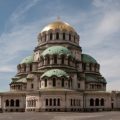
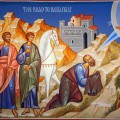
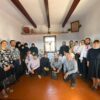 Memorial house of romanian elder Sofian Boghiu Consecrated in his native Village
Memorial house of romanian elder Sofian Boghiu Consecrated in his native Village 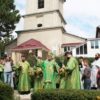 On the 14th Sunday after Pentecost, His Eminence Metropolitan Vladimir celebrated the Divine Liturgy in the St. Nicolas Monastery, Dobrusa village, Soldanesti region
On the 14th Sunday after Pentecost, His Eminence Metropolitan Vladimir celebrated the Divine Liturgy in the St. Nicolas Monastery, Dobrusa village, Soldanesti region 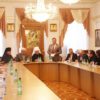 Inauguration of the volume of articles presented at the National Scientific Conference “The Orthodox Church and the State: Faith and Knowledge”
Inauguration of the volume of articles presented at the National Scientific Conference “The Orthodox Church and the State: Faith and Knowledge” 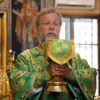 The 12th Sunday after Pentecost – kindness in God changes the world we live in
The 12th Sunday after Pentecost – kindness in God changes the world we live in 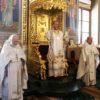 The 11th Sunday after Pentecost – loving our God and our neighbor
The 11th Sunday after Pentecost – loving our God and our neighbor 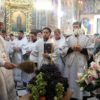 The Transfiguration of the Lord, celebrated in the Nativity of the Lord Cathedral in Chisinau
The Transfiguration of the Lord, celebrated in the Nativity of the Lord Cathedral in Chisinau 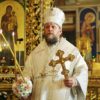 His Eminence Metropolitan Vladimir celebrates 65th anniversary
His Eminence Metropolitan Vladimir celebrates 65th anniversary  Divine Service at the St. Theodore of Tyre Monastery (Ciuflea) in Chisinau, and congratulation of Archimandrite Nicolae (Rosca), the Monastery’s confessor-administrator, on the 50th anniversary.
Divine Service at the St. Theodore of Tyre Monastery (Ciuflea) in Chisinau, and congratulation of Archimandrite Nicolae (Rosca), the Monastery’s confessor-administrator, on the 50th anniversary.  The Tenth Sunday after Pentecost: Divine Liturgy in the Nativity of the Lord Cathedral in Chisinau
The Tenth Sunday after Pentecost: Divine Liturgy in the Nativity of the Lord Cathedral in Chisinau 